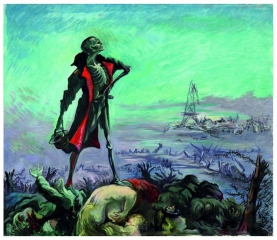From 16 March until 28 July 2013, Stadtmuseum Berlin presents the exhibition “verfemt, verfolgt – vergessen? Kunst und Künstler im Nationalsozialismus”1 with various works from the impressive Collection Gerhard Schneider at its location Emphraim-Palais. On the occasion of the theme year “Diversity Destroyed” on the Nazi’s takeover 100 years ago, the Stadtmuseum Berlin thus remembers the methodic defamation of modern art, up to destruction of artworks and lives. The exhibition is dedicated to all artists who had been banned, persecuted or even murdered, and whose works and lives have been nearly forgotten. It is therefore even more necessary to remember their suffering, but not the least their lives and works, to snatch them from oblivion.

The art collector Dr. Gerhard Schneider devoted his life to save such works and their creators, e.g. in his Bürgerstiftung für verfemte Künste mit der Sammlung Gerhard Schneider, Solingen”.2 Its works had been sidelined often, e.g. as “entartete Kunst” (degenerate art). In the collection – with more than 400 artists – are many works that critically address political issues while the public back then was hardly interested in them: one may think of the works about the First World War that were made 1914-1918 , while today’s perception of war about WW1 is dominated by artists such as Otto Dix or George Grosz, whose works are mainly from the post-war period.
For this exhibition, primarily artworks with relations to Berlin were chosen, e.g. by Georg Netzband (1900-1984). Born in Berlin, he unterwent as an 18-year-old the First World War’s last months; thereafter, he went to the Staatliche Kunstschule Berlin (public school of arts). The Nazis saw him as “politically unreliable”: he was cited to Gestapo on several occasions, and in 1936, he received bans on travelling and exhibiting. Netzband continued to secretly paint, including the downright visionary picture “Der Sieger” (the victor) from 1939: death is posing heroically on a heap of corpses, wearing a German General’s uniform. Netzband was drafted for the Second World War, too; wounded at the Eastern Front, he became Soviet prisoner of war, from where he returned in 1947/48. The painter always regarded himself as chronicler, not the least of his home town. It is worth to rediscover him and other artists in this exhibition.
“verfemt, verfolgt – vergessen? Kunst und Künstler im Nationalsozialismus”
Works from the Collection Gerhard Schneider
16 March until 28 July 2013, Tu/Th-Su 1000-1800h, We 1200-2000h
Entrance fee 5,- € (concessions 3,- €; free of charge each month’s first Wednesday)
On 14 March 2013, the exhibition will be opened with the concert “Verehrt – verfemt – versunken” (2000h at St. Nicholas Church.
Stadtmuseum Berlin
Emphraim-Palais
Poststr. 16
10178 Berlin
Germany

Hallo Herr Bayer, nachdem wir uns gestern im Babylon trafen, lese ich heute mit Interesse Ihren BLOG. Und stelle eine kleine Gemeinsamkeit fest. Auch ich habe die Ausstellung im Ephraim Palais kommentiert:
http://nikolaiviertel-aktuell.blogspot.de/2013/03/ausstellung-im-ephraim-palais.html
Beste Grüße
Fritz